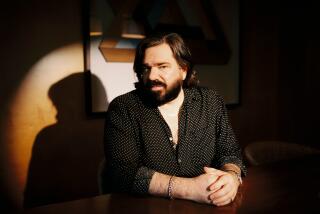Jan Berry, 62; Recorded Hit Songs in Pop Duo Jan and Dean
Jan Berry, half of the 1960s pop music duo Jan and Dean, who recorded such hits as their No. 1 “Surf City” and Berry’s personal favorite, “Dead Man’s Curve,” has died. He was 62.
Berry died Friday at UCLA Medical Center after suffering a seizure at his Brentwood home, his wife, Gertrude Filip Berry, told The Times on Saturday. His health had been precarious since he suffered brain damage and partial paralysis in a 1966 automobile accident.
For the record:
12:00 a.m. April 1, 2004 For The Record
Los Angeles Times Thursday April 01, 2004 Home Edition Main News Part A Page 2 National Desk 1 inches; 43 words Type of Material: Correction
Jan Berry -- The obituary in Sunday’s California section of singer Jan Berry, of the pop duo Jan and Dean, incorrectly stated that the song “Surf City” contained the phrase “two girls for every guy.” The phrase is “two girls for every boy.”
Along with his friend Dean Torrence, Berry had half a dozen hits in the Top 10, including their 1959 “Baby Talk,” and five Top 10 hits in 1963 and 1964 alone -- “Surf City,” “Honolulu Lulu,” “Drag City,” “Dead Man’s Curve” and “The Little Old Lady From Pasadena.” They collected 13 golds and sold more than 10 million records.
Torrence could not be reached Saturday for comment.
Steeped in the surf, sun and sand culture of Southern California youth of the late 1950s and early 1960s, Berry delighted in spinning lyrics about a hot-rod racing grandma in “The Little Old Lady From Pasadena” or driving a “woody” to “Surf City,” where he envisioned “two girls for every guy.” He and Brian Wilson of the Beach Boys wrote the lyrics for several Jan and Dean hits, including “Dead Man’s Curve,” “Drag City,” “Surf City” and “New Girl in School.”
“Jan and Brian influenced each other so much; they had one of the most important friendships in popular music, particularly in developing the West Coast sound,” said Mark Moore, who is writing a biography of Berry. He said Wilson learned about producing records from Berry, and Berry gained insight on harmony from Wilson.
The Beach Boys and Jan and Dean even performed on each other’s records until their respective record companies objected, according to the New Rolling Stone Encyclopedia of Rock & Roll.
Jan and Dean’s meteoric career might have soared higher but for the April 12, 1966, accident in which Berry’s silver Corvette Stingray hit a parked truck at 90 mph on Whittier Drive in Beverly Hills, only a few blocks from the legendary “Dead Man’s Curve” of their song, which is on Sunset Boulevard.
Although the accident, which put Berry in a coma for 10 months, initially left him unable to talk and walk, through sheer determination he regained the ability to walk and to speak slowly.
“Part of all that drive and all that ego and all that stuff ended up working in his favor, getting him up and out of that wheelchair,” Torrence told the Augusta Chronicle in 1997. Torrence, although continuing to perform, built a new career designing album covers.
Berry’s right hand and arm remained paralyzed, reducing his instrumental repertoire from ukulele, guitar and many other instruments to only one-handed piano. He had difficulty remembering lyrics he had written, and backstage would go over them repeatedly while listening to a portable cassette player.
But he was able to resume performing with Torrence in the late 1970s after a 1978 television movie, “Dead Man’s Curve,” renewed interest in Jan and Dean. The duo split briefly in 1981 when Berry developed a cocaine habit -- another handicap he overcame and talked openly about.
Performing, and occasionally writing, songs remained draining to Berry, who spent much of his offstage time in bed, according to his wife. Yet, because of Berry’s determination, Jan and Dean continued to join Beach Boys tours and recently played a concert in El Cajon. In 1998, Berry recorded a solo CD, “Second Wave.”
“He was an inspiration to everybody wherever he would go,” said his wife.
“He has been a high-profile example for other handicapped people since 1966,” said Moore. “He is always on stage at whatever cost to him, even if he is in a wheelchair. He was just not to be stopped.”
He was born William Jan Berry on April 3, 1941, and played football with Torrence at Emerson Junior High School and University High in West Los Angeles. The two youths began singing together, along with Arnie Ginsburg, drummer Sandy Nelson and future Beach Boy Bruce Johnston, as the Barons.
In 1958, Berry, Torrence and Ginsburg recorded “Jennie Lee” for Arwin Records, about a crush on a local stripper. The song was No. 8 on the charts. When the contracts were signed, however, Torrence was serving in the National Guard, so the single was credited to Berry and Ginsburg.
When Torrence returned from duty, and Ginsburg joined the Army, Jan and Dean quickly moved toward surf music superstardom.
Known for his remarkable intelligence, Berry, whose IQ was reportedly 180, handled his musical career while earning a degree in zoology at UCLA. The accident halted his plans to become a medical doctor.
In 1986, Berry lent his name to the government-funded Jan Berry Center for the Brain Injured in Downey to assist others who had suffered physical problems similar to his. The center is near the Rancho Los Amigos Hospital, where he went for treatment.
The A&E; show “Biography” memorialized Berry and Torrence in a 2002 segment titled “Jan & Dean -- The Other Beach Boys.”
In addition to his wife of 13 years, Berry is survived by his parents, William and Clara Berry of Camarillo, three brothers and three sisters.
Berry’s wife said he had donated his body to medical science. She said because Berry strongly disliked funerals, there would be no formal service.
More to Read
The biggest entertainment stories
Get our big stories about Hollywood, film, television, music, arts, culture and more right in your inbox as soon as they publish.
You may occasionally receive promotional content from the Los Angeles Times.










